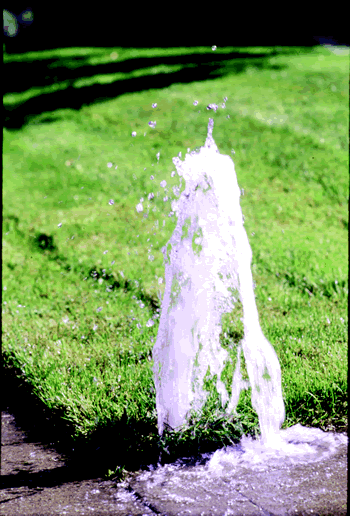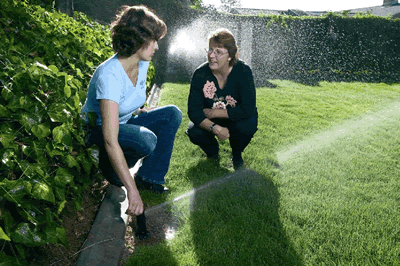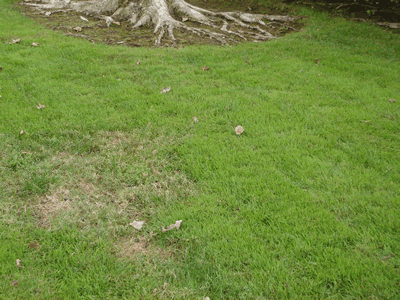|
Maintain the Irrigation System
| • | Leaks and/or breaks: Once a month throughout the irrigation season (April through October/November), run your system in manual mode to check for leaks or breaks. This helps to protect against plant loss and offers a simple way to be water wise. Also look for: broken or tilted sprinkler heads; rotors stuck in place; misting (indicates water pressure is too high); uneven water coverage due to head spacing (water sprayed from each sprinkler head should reach adjacent sprinkler heads); heads not at grade (too high or too low); mismatched sprinkler heads and nozzles (prevents even precipitation rates); spray patterns blocked by plants; clogged nozzles or drip emitters; clogged filters; leaking or separated drip lines; missing emitters. |

A broken head not only wastes water, but if not repaired will create brown spots in the lawn.
If sprinkler heads or drip emitters become clogged, they will need to be flushed. For sprinkler systems - remove individual nozzles from sprinklers. Turn system on for a few minutes until a clean, solid stream of water flows from each sprinkler head. Turn system off. Check nozzles before replacing to be sure they are not clogged. Clean and replace clogged nozzles. Turn system on and check for proper operation.
For drip systems - remove end caps from drip lines. Turn system on for a few minutes until a clean, solid stream of water flows from the end of the line(s). Turn system off. Replace end caps. Turn system on and check for proper operation. Replace emitters that are not functioning properly.
| • | Adjusting sprinklers: Adjust sprinkler heads as much as possible so that water from each head just reaches the adjacent head(s). This 100% overlapping pattern improves water coverage and can reduce dry spot and wet spot problems. |

Check the arc of rotor and impact sprinklers to ensure that they are not overspraying onto driveways and walks.
| • | Hardware compatibility: Determine if sprinkler heads within each valve circuit match (not all brands and models are interchangeable and/or compatible). Be sure that sprinkler heads within each valve circuit have the same precipitation rate for even coverage. Additionally, the radius of nozzles (the distance the nozzle is designed to spray water) should match actual spacing of sprinkler heads to achieve head-to-head coverage. |
| • | Faucets: Check to be sure there is no leak. |
| • | Outdoor water pipes: Protect any that are exposed to winter freeze. Wrap them with pipe insulation to avoid inconvenient and costly breaks. Copper wire or plastic wire ties work best to keep insulation in place. |
| • | Dry or wet spots: If very dry spots, or soft wet spots, occur in lawn or shrub areas, make adjustments to improve irrigation system inefficiencies. |

Find and fix the cause of brown spots
| • | Perfection: If soil is dry or slightly damp on the surface and the lawn springs back when walked on, the schedule should not be modified. The station’s irrigation schedule is on target. |
| 